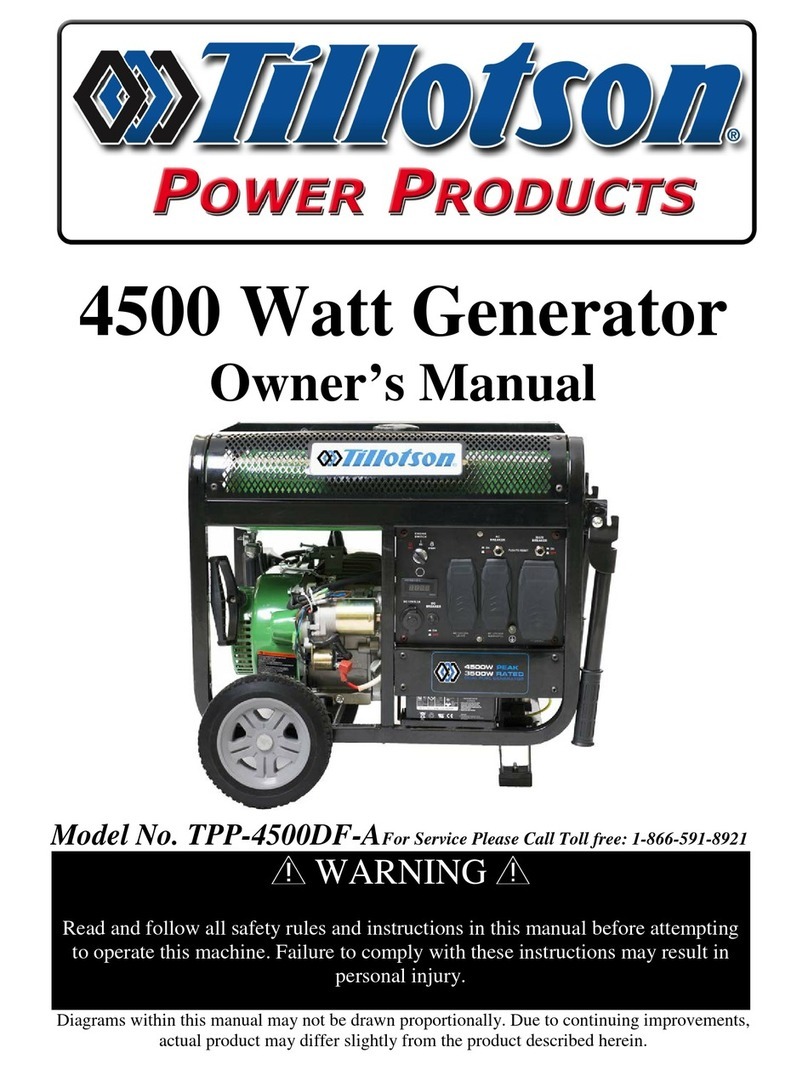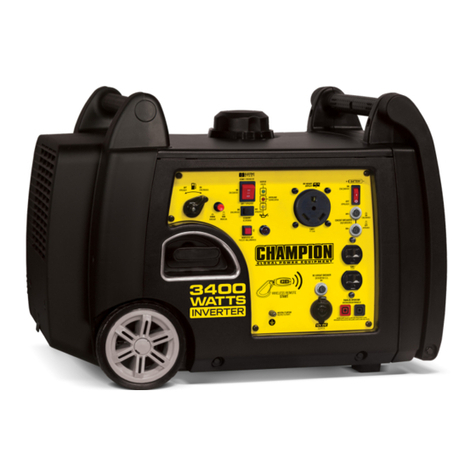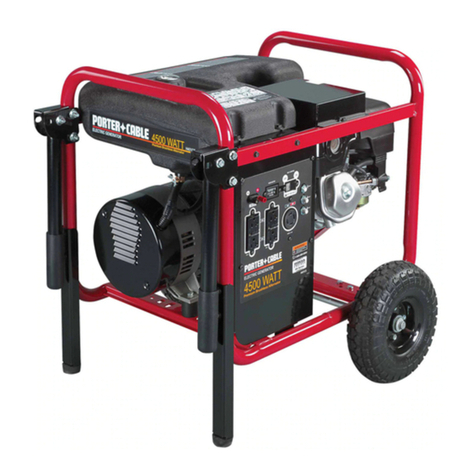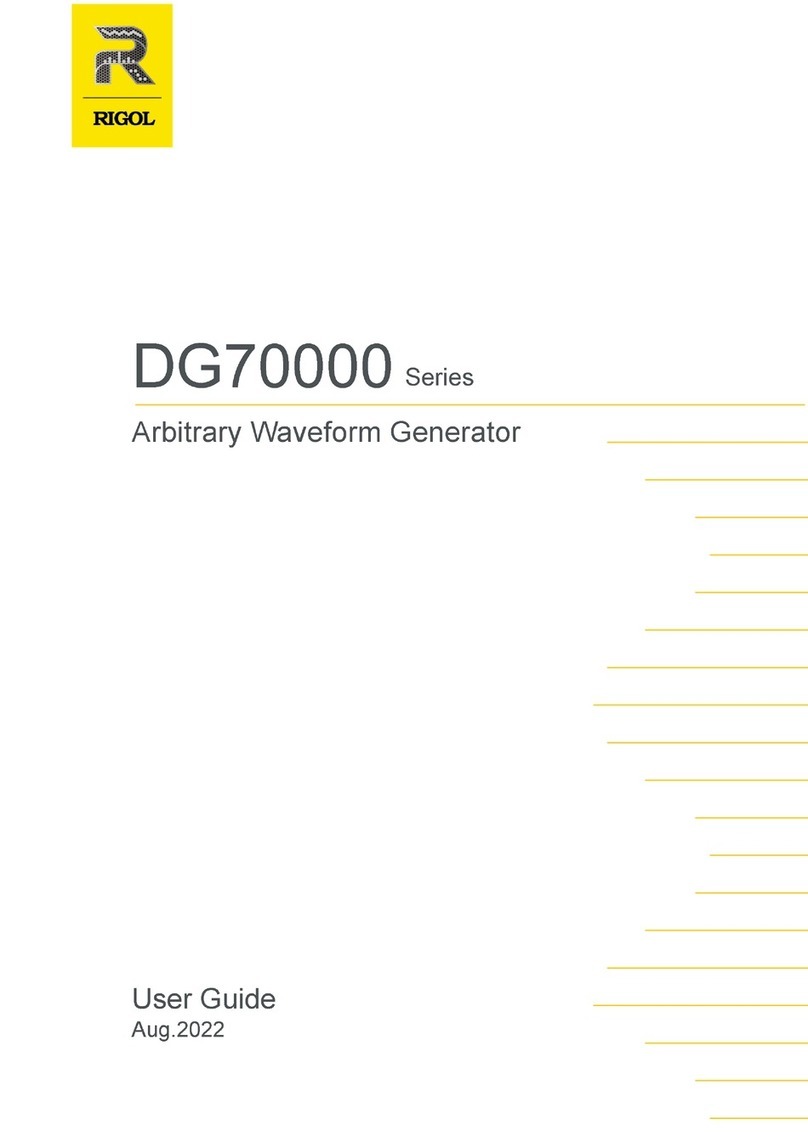TILLOTSON TPP-4500G-A User manual

4500 Watt Generator
Owner’s Manual
Model No. TPP-4500G-A For Service Please Call Toll free: 1-866-591-8921
WARNING
Read and follow all safety rules and instructions in this manual before attempting
to operate this machine. Failure to comply with these instructions may result in
personal injury.
Diagrams within this manual may not be drawn proportionally. Due to continuing improvements,
actual product may differ slightly from the product described herein.

2
TABLE OF CONTENTS
SAFETY GUIDELINES ..................................................................................................................3
GENERATOR COMPONENTS....................................................................................................13
WATTAGE REFERENCE CHART..............................................................................................16
PRE-OPERATION CHECK ..........................................................................................................17
STARTING THE GENERATOR...................................................................................................18
STOPPING THE GENERATOR ...................................................................................................19
OPERATION INSTRUCTIONS....................................................................................................20
MAINTENANCE...........................................................................................................................22
STORAGE......................................................................................................................................25
INSTALLATION ...........................................................................................................................26
TROUBLESHOOTING .................................................................................................................27
WIRING DIAGRAM .....................................................................................................................29
MODEL SPECIFICATIONS .........................................................................................................29
The engine exhaust from this product
contains chemicals known to the State of
California to cause cancer, birth defects or
other reproductive harm.
WARNING:

3
Safety Guidelines
This manual contains important information that you need to know and understand in order to
protect YOUR SAFETY and to PREVENT EQUIPMENT PROBLEMS. The following symbols
help you recognize this information. These labels warn you of potential hazards that can cause
serious injury. Read them carefully.
Please read the manual and pay attention to these sections.
Save These Important Safety Instructions!
Read and understand all of these safety instructions. Be sure to retain
them for future use.
WARNING! Warnings indicate a certainty or strong possibility of
personal injury or death if instructions are not followed.
CAUTION: Cautions indicate a possibility of personal injury or
equipment damage if instructions are not followed.
NOTE: Notes give helpful information.

4
General Precautions
WARNING! FAILURE TO FOLLOW THESE INSTRUCTIONS
CAN RESULT IN SEVERE INJURY OR DEATH.
CAUTION: FAILURE TO FOLLOW THESE INSTRUCTIONS CAN
ALSO RESULT IN DAMAGE TO THE TOOL AND/OR THE ITEM
YOU ARE WORKING ON
WARNING! IMPROPER OPERATION OR MAINTENANCE OF
THIS PRODUCT COULD RESULT IN SERIOUS INJURY AND
PROPERTY DAMAGE. READ AND UNDERSTAND ALL
WARNINGS AND OPERATING INSTRUCTIONS BEFORE USING
THIS EQUIPMENT. WHEN USING AIR TOOLS, BASIC SAFETY
PRECAUTIONS SHOULD ALWAYS BE FOLLOWED TO
REDUCE THE RISK OF PERSONAL INJURY.
Specific Warnings
Carbon Monoxide
When this tool is running, ensure that the area is well ventilated. Never run
the engine in an enclosed area. Run the engine in an open area or with an
exhaust evacuation system in an enclosed area.
WARNING! THE EXHAUST CONTAINS POISONOUS CARBON
MONOXIDE GAS THAT CAN BUILD UP TO DANGEROUS LEVELS
IN CLOSED AREAS. BREATHING CARBON MONOXIDE CAN
CAUSE UNCONSCIOUSNESS OR DEATH.
•Never run the generator in a closed or even partly closed area where
people may be present.
Gasoline and Oil

5
This product requires oil and fuel. Attempting to start the engine without oil
will ruin the engine and void the warranty. Work in a well-ventilated area.
Keep cigarettes, flames or sparks away from the work area or where gasoline
is stored.
GASOLINE IS HIGHLY FLAMMABLE AND EXPLOSIVE. YOU
COULD BE BURNED OR SERIOUSLY INJURED IF THE GASOLINE
IS IGNITED.
•Before refueling, stop the engine and keep heat, sparks and flame away.
•Handle fuel only outdoors.
•Do not fill the fuel tank above the upper limit line.
•Wipe up fuel and oil spills immediately.
•Gasoline and its fumes are flammable and potentially explosive. Use
proper fuel storage and handling procedures. ALWAYS HAVE
MULTIPLE ABC CLASS FIRE EXTINGUISHERS HANDY.
•KEEP THE GENERATOR AND SURROUNDING AREA CLEAN AT
ALL TIMES. Dispose of fluids and cleaning materials as per any local,
state, or federal codes and regulations. Store oily rags in a covered metal
container.
•NEVER STORE FUEL OR OTHER FLAMMABE MATERIALS NEAR
THE GENERATOR.
•Do not smoke or allow sparks, flames or other sources of ignition around
the engine and fuel tank. Fuel vapors are explosive.
•Keep grounded conductive objects, such as tools, away from exposed,
live electrical parts and connections to avoid sparking or arcing. These
events could ignite fumes or vapors.
•Do not refill the fuel tank while the engine is running or while the engine
is still hot. Do not operate the generator with known leaks in the fuel
system.
•Excessive buildup of unburned fuel or gases in the exhaust system can
create a potentially explosive condition. This buildup can occur after
repeated failed start attempts, valve testing, or hot engine shutdown. If
this occurs, open exhaust system drain plugs, if equipped, and allow the
gases to dissipate before attempting to restart the generator.
•Only use engine oil and fuel recommended by manufacturer.
Hot Components
WARNING! ENGINE AND EXHAUST SYSTEM PARTS BECOME
VERY HOT AND REMAIN HOT FOR SOME TIME AFTER THE
ENGINE HAS STOPPED. WEAR INSULATED GLOVES OR WAIT
UNTIL THE ENGINE AND EXHAUST SYSTEM HAVE COOLED
BEFORE HANDLING THE PARTS.
Electrical Safety

6
Grounded tools must be plugged into an outlet properly installed and
grounded in accordance with all codes and ordinances. Never remove the
grounding prong or modify the plug in any way. Do not use any adapter
plugs.
Grounding provides a low-resistance path to carry electricity away from the
user in the event of an electrical malfunction.
Double insulated tools are equipped with a polarized plug, where one blade is
wider than the other. This plug fits in a polarized outlet only one way. If the
plug does not fit fully in the outlet, reverse the plug. If it still does not fit,
contact a qualified electrician to install a polarized outlet. Do not change the
plug in any way. Double insulation eliminates the need for the three-wire
grounded power cord and grounded power supply system.
Avoid body contact with grounded surfaces such as pipes, radiators, ranges,
and refrigerators. There is an increased risk of electric shock if your body is
grounded.
Do not abuse the power cord for your tools or equipment. Keep power cords
away from heat, oil, sharp edges, or moving parts. Replace damaged power
cords immediately. Damaged power cords increase the risk of electric shock.
When operating a power tool outside, use an outdoor extension cord marked
“W-A” or “W”. These extension cords are rated for outdoor use, and reduce
the risk of electric shock.
Connect the generator only to a load or electrical system (120 volt) that is
compatible with the electrical characteristics and rated capacities of the
generator.
Before servicing equipment powered by the generator, disconnect the
equipment from its power input.
Insulate all connections and disconnected wires.
Guard against electric shock. Prevent body contact with grounded surfaces
such as pipes, radiators, ranges, and refrigerator enclosures.

7
IMPROPER CONNECTIONS TO A BUILDING CAN ALLOW
ELECTRICAL CURRENT TO BACK FEED INTO UTILITY LINES,
CREATING AN ELECTROCUTION HAZARD.
•CONNECTIONS TO A BUILDING MUST ISOLATE THE
GENERATOR POWER FROM UTILITY POWER AND COMPLY
WITH ALL APPLICABLE LAWS AND ELECTRICAL CODES.
•All connections and conduits from the generator to the load must only be
installed by trained and licensed electricians, and in compliance with all
relevant local, state, and federal electrical codes and standards, and other
regulations where applicable.
•The generator must be earth-grounded for fixed installations in
accordance with all relevant electrical codes and standards before
operation.
THE GENERATOR IS A POTENTIAL SOURCE OF ELECTRICAL
SHOCK IF NOT KEPT DRY.
•DO NOT EXPOSE THE GENERATOR TO MOISTURE, RAIN OR
SNOW. Water entering a generator will increase the risk of electric
shock.
•DO NOT OPERATE THE GENERATOR WITH WET HANDS.
•Do not attempt to connect or disconnect load connections while standing
in water, or on wet or soggy ground.
•Do not touch electrically energized parts of the generator and
interconnecting cables or conductors with any part of the body, or with
any non-insulated conductive object.
•Keep all electrical equipment clean and dry. Replace any wiring where
the insulation is cracked, cut abraded or otherwise degraded. Replace
terminals that are worn, discolored, or corroded. Keep terminals clean
and tight.
Power Output
This generator is not designed to power sensitive electronic equipment (such
as computers, mobile phones, medical devices and the like) without the
addition of an approved line conditioner, which is sold separately.
ATTEMPTING TO POWER SENSITIVE ELECTRONIC
EQUIPMENT WITHOUT THE USE OF AN APPROVED LINE
CONDITIONER MAY CAUSE DAMAGE TO THE EQUIPMENT.
NEITHER TILLOTSON POWER PRODUCTS LLC NOR ANY OF ITS
AFFILIATES ARE RESPONSIBLE FOR ANY DIRECT OR
INDIRECT DAMAGE CAUSED BY FAILURE TO USE AN
APPROVED LINE CONDITIONER.
Work Area

8
Keep your work area clean and well lit. Cluttered benches and dark areas
invite accidents.
Do not operate power tools in explosive atmospheres, such as in the presence
of flammable liquids, gases, or dust. Generators create sparks which may
ignite the dust or fumes.
Keep bystanders, children and visitors away while operating a generator.
Provide barriers or shields as needs.
Personal Safety
Stay alert. Watch what you are doing, and use common sense when operating
a generator. Do not use generator while tired or under the influence of drugs,
alcohol, or medication. A moment of inattention while operating generators
may result in serious personal injury.
Dress properly. Do not wear loose clothing or jewelry. Contain long hair.
Keep your hair, clothing, and gloves away from moving parts. Loose clothes,
jewelry, or long hair can be caught in moving parts.
Avoid accidental starting. Make sure the power switch is in its “OFF”
position and disconnect the spark plug wire when not in use.
Remove adjusting keys or wrenches before turning the generator on. A
wrench or a key that is left attached to a rotating part of the generator may
result in personal injury.
Do not overreach. Keep proper footing and balance at all times.
Use safety equipment. Always wear eye protection. Wear ANSI approved
safety impact eye goggles. Dust mask, non-skid safety shoes, hardhat, or
hearing protection must be used for appropriate conditions.
Do not force the generator. Use the correct generator for your application.
The correct generator will do the job better and safer at the rate for which it is
designed.
Do not use the generator if the power switch does not turn it off. Any
generator that cannot be controlled with the power switch is dangerous and
must be replaced.
Generator Use and Care

9
Make sure the power switch is in its “OFF” position and disconnect the spark
plug wire before making any adjustment, changing accessories, or storing the
generator. Such preventative safety measures reduce the risk of starting the
generator accidentally.
Store idle generators out of reach of children and other untrained persons.
Generators are dangerous in the hands of untrained users.
Maintain generators with care. Do not use a damaged generator. Tag damaged
generators “Do not use” until repaired.
Check for misalignment or binding of moving parts, broken parts, and any
other condition that may affect the generator’s operation. If damaged, have
the generator serviced before using. Many accidents are caused by poorly
maintained generators.
Use only accessories that are recommended by the manufacturer for your
model. Accessories that may be suitable for one generator may become
hazardous when used on another generator.
Servicing
Maintain labels and nameplates on the generator and engine. These carry
important information. If unreadable or missing, contact the service number
on the front page of this manual or Tillotson Power Products LLC
immediately for a replacement.
Generator service must be performed only by qualified repair personnel.
Service or maintenance performed by unqualified personnel could result in a
risk of injury.
When servicing a generator, use only identical replacement parts. Follow all
appropriate instructions in this manual. Use of unauthorized parts or failure to
follow maintenance instructions may create a risk of electric shock or injury.
Heart Pacemakers
WARNING! PEOPLE WITH PACEMAKERS SHOULD CONSULT
THEIR PHYSICIAN(S) BEFORE USING THIS PRODUCT.
ELECTROMAGNETIC FIELDS IN CLOSE PROXIMITY TO A
HEART PACEMAKER COULD CAUSE INTERFERENCE TO OR
FAILURE OF THE PACEMAKER.
Installation

10
Ensure installation meets all applicable safety, local and national electrical
codes. Have installation performed by a qualified, licensed electrician and
building contractor.
All electrical work, including the earth-ground connection, should be
completed by a licensed electrician.
Any separate fuel storage or generator supply facility must be built or
installed in full compliance with all relevant local, state, and federal
regulations.
It is recommended to use the generator only in well-ventilated, outdoor
areas. A running gasoline engine will generate carbon monoxide, a
colorless, odorless gas that, if inhaled, can cause serious injury or death.
If the generator is installed indoors, exhaust fumes must be piped out of the
building using leak-free, heat resistant piping. Pipes and silencer should not
use any flammable materials, nor should they be installed near the same.
Generator exhaust fumes must be within legal limits and installation must
always meet local building codes.
If the generator is installed outdoors, it must be weatherproofed and should be
soundproofed. It should not be run outdoors without protection to the
generator and wiring conduit.
Before lifting the generator, ensure the lift rigging and supporting structure
are in good condition, and are rated to lift such a load.
Keep all personnel away from the suspended generator during relocating.
The supporting floor/ground surface should be level and strong enough to
safely hold the weight of the generator. If the floor/grounded surface is not
level, strong cross members should be placed under the full length of the
generator frame at its low side.
For trailer installation, the generator should be mounted on the center point of
the trailer, over the wheels. The trailer must be capable of supporting the
weight of the generator and all contents (tools, etc.).
Install sound-and weatherproofing only when it is not raining or snowing to
avoid trapping moisture within the generator’s area.
Mechanical

11
Always make sure the power switch is in its “OFF” position. Disconnect the
spark plug wire, and allow the engine to completely cool before carrying out
maintenance.
Check for damaged parts. Before using the generator, any part that appears
damaged should be carefully checked to determine that it will operate
properly and perform its intended function. Check for alignment and binding
of moving parts, any broken parts or mounting fixtures, and any other
condition that may affect proper operation.
The generator is designed with guards for protection from moving parts. Care
must still be taken to protect personnel and equipment from other mechanical
hazards when working around the generator.
Do not operate the generator with safety guards removed. While the generator
is running, do not attempt to reach around the safety guard for maintenance or
any other reason.
Keep hands, arms, long hair, loose clothing, and jewelry away from moving
parts. Be aware that when engine parts are moving fast they cannot be seen
clearly.
Keep access doors on enclosures closed and locked when access is not
required.
When working on or around the generator, always wear protective clothing,
including ANSI approved safety gloves, safety eye goggles, and safety hat.
Do not alter or adjust any part of the generator that is assembled and supplied
by the manufacturer.
Always follow and complete scheduled engine and generator maintenance.
Chemicals
Avoid contact with hot fuel, oil, exhaust fumes, and hot solid surfaces.
Avoid body contact with fuels, oils, and lubricants used in the generator. If
swallowed, seek medical treatment immediately. Do not induce vomiting if
fuel is swallowed. For skin contact, immediately wash with soap and water.
For eye contact, immediately flush eyes with clean water and seek medical
attention.
Noise
Prolonged exposure to noise levels above 68 DBA is hazardous to hearing.
Always wear ANSI approved ear protection when operating or working
around the generator when it is running.

12
Additional Safety Information
Operator Responsibility
!Know how to stop the generator quickly in case of emergency. See page 19.
!Understand the use of all generator controls, output receptacles and connections.
!Do not let children operate the generator without parental supervision.
Electric Shock Hazards
!The generator produces enough electric power to cause a serious shock or electrocution if
misused.
!Using a generator or electrical appliance in wet conditions, such as rain or snow, or near a
pool or sprinkler system, or when your hands are wet, could result in electrocution. Keep the
generator dry.
!If the generator is stored outdoors, unprotected from the weather, check all of the electrical
components on the control panel before each use.
!Moisture or ice can cause a malfunction or short circuit in electrical components, which
could result in electrocution.
!Do not connect to a building electrical system unless a qualified electrician has installed an
isolation switch.
Fire and Burn Hazards
!The exhaust system gets hot enough to ignite some materials.
•Keep the generator at least 3 feet (1 meter) away from buildings and other equipment
during operation.
•Do not enclose the generator in any structure. Keep flammable materials away from the
generator.
!The muffler becomes very hot during operation and remains hot for a while after stopping
the engine. Be careful not to touch the muffler while it is hot. Let the engine cool before
storing the generator indoors.
!Gasoline is extremely flammable and is explosive under certain conditions. Do not smoke or
allow flames or sparks where the generator is refueled or where gasoline is stored. Refuel in
a well-ventilated area with the engine stopped.
!Fuel vapors are extremely flammable and may ignite after the engine has started. Make sure
that any spilled fuel has been wiped up before starting the generator.

13
GENERATOR COMPONENTS
See next page for further explanations.

14
Engine Key Positions:
Off: Key should be in the OFF position when generator is not in use. Key may also be
turned to the off position to stop the engine.
ON: Key should be in the ON positions while engine is running or prior to starting the
engine with the remote or recoil starter.
START: Turn key to start position to start the engine.
Do not turn the key switch to START position when the engine is running.
Doing so may damage the starting motor.
Do not leave key in the ignition unattended.
For starting instructions, see STARTING THE GENERATOR on page 18.
Recoil Starter:
The recoil starter may be used to start the engine instead of the key or remote start or if the battery
is discharged. To start the engine, pull the starter grip lightly until resistance is felt, then pull
briskly. Repeat as necessary to start. See STARTING THE GENERATOR on page 16 for more
information.
Do not allow the recoil starter handle to snap back against the engine.
Return it gently to prevent damage to the starter.
When starting the engine by recoil starter, set the key switch to the ON
position and pull the recoil starter handle.
Fuel Valve:
The fuel valve is located between the fuel tank and carburetor. When the
lever is in the off (horizontal) position, the valve is closed and fuel will not
flow from the gas tank to the engine.
When the valve lever is turned to the ON (vertical) position, fuel is
allowed to flow from the fuel tank to the carburetor.
Be sure to return the fuel valve lever to the OFF position after stopping the
engine.
Choke Lever:
The choke is used to help start a cold engine. The choke
shutter reduces the amount of air being mixed with fuel, thus
providing an enriched fuel mixture which combusts more
easily. The choke is designed to operate automatically with
the remote starting feature, but must be opened and closed
manually when using the key or recoil start. The choke is
closed for starting when the large rectangular portion of the
choke lever is rotated as far as it will easily go toward in a
counter-clockwise direction (toward the air filter). Once the
Shown
off

15
engine has started and is running steadily, the choke should be opened (disengaged) by turning the
lever as far as it will easily go clockwise (away from the air filter).
Ground Terminal:
The generator ground terminal is connected to the frame of the generator, the metal non-current-
carrying parts of the generator and the ground terminals of each receptacle.
DC Circuit Breaker:
The DC circuit breaker automatically shuts off the DC battery charging circuit when the DC
charging circuit is overloaded, when there is a problem with the battery or when the connections
between the battery and the generator are improper.
Oil Alert System:
The Oil Alert system is designed to prevent engine damage caused by an insufficient amount of
oil in the crankcase. Before the oil level in the crankcase can fall below a safe limit, the Oil Alert
system will automatically stop the engine (the engine switch will remain in the ON position). The
Oil Alert system should not take the place of checking the oil level before each use. If the engine
stops and will not restart, check the engine oil level before troubleshooting in other areas.
AC Circuit Breaker:
The AC circuit breaker will automatically switch OFF if there is a short circuit or a significant
overload of the generator at the receptacle. If the AC circuit breaker is switched OFF
automatically, check that the appliance is working properly and does not exceed the rated load
capacity of the circuit before switching the AC circuit breaker ON again. The AC circuit breaker
may be used to switch the generator power ON or OFF.

16
WATTAGE REFERENCE CHART
Electric equipment, especially engines, produce strong current when being started. The table
below offers references when you connect those installations to generator.
Tool or Appliance
Rated*
(Running) Watts
Additional Surge
(Starting) Watts
Essentials
Light Bulb – 75 watt
75
–
Deep Freezer
500
500
Sump Pump
800
1200
Refrigerator/Freezer – 18 cu. ft.
800
1600
Water Well Pump – ⅓HP
1000
2000
Heating/Cooling
Window Air Conditioner – 10000 BTU
1200
1800
Window Fan
300
600
Furnace Fan Blower – ½HP
800
1300
Kitchen
Microwave Oven – 1000 watt
1000
–
Coffee Maker
1500
–
Electric Stove – Single Element
1500
–
Hot Plate
2500
–
Family Room
DVD/CD Player
100
–
VCR
100
–
Stereo Receiver
450
–
Color Television- 27”
500
–
Personal Computer w/17” Monitor
800
–
Other
Security System
180
–
AM/FM Clock Radio
300
–
Garage Door Opener- ½HP
480
520
Electric Water Heater – 40 Gallon
4000
–
DIY / Job Site
Quartz Halogen Work Light
1000
–
Airless Sprayer – ⅓HP
600
1200
Reciprocating Saw
960
960
Electric Drill- ½HP
1000
1000
Circular Saw – 7 ¼”
1500
1500
Miter Saw – 10”
1800
1800
Table Planer- 6”
1800
1800
Table Saw / Radial Arm Saw – 10”
2000
2000
Air Compressor – 1 ½HP
2500
2500
*Wattages listed are approximate only. Check tool or appliance for actual wattage.

17
PRE-OPERATION CHECKLIST
1. Connect the Battery
!Connect the positive wire to the positive terminal of the battery and the negative wire to
the negative terminal of the battery.
2. Fill or Check the Engine Oil
!CAUTION: PRIOR TO FIRST USING THE GENERATOR, THE ENGINE MUST
BE FILLED WITH A HIGH QUALITY SAE 10W-30 OR OTHER SUITABLE
GRADE ENGINE OIL. To do so, unscrew and remove the engine’s oil dipstick located
at the bottom of the engine crankcase. Fill the engine’s crankcase with the included oil
until the oil level is level with the upper marked line on the dipstick, and then screw the
dipstick back into the oil fill hole. FILL OIL ON A LEVEL SURFACE.
!Check the oil level BEFORE EACH USE with the generator on a level surface and
the engine stopped.
oRemove the oil filler cap and wipe the dipstick clean.
oCheck the oil level by inserting the dipstick into the filler neck without screwing it in.
oIf the level is low, fill to the top of the oil filler heck with the recommended oil (see
below). Use the enclosed funnel to avoid spilling oil.
!Use only 4-stroke motor oil that meets or exceeds the
requirements for API service classification SJ. SAE 10W-
30 is recommended for general, all-temperature use. Other
viscosities shown in the chart may be used when the
average temperature in your area is within the indicated
range.
!

18
Engine oil is a major factor affecting engine performance and service life.
Non-detergent and 2-stroke engine oils will damage the engine and are not
recommended. Always check the API SERVICE label on the oil container
to be sure it includes the letter SJ.
3. Fuel
!Check the fuel gauge and refill the tank if the fuel level is low. Do not use gasoline with
more than 10% ethanol.
!Refuel carefully to avoid spilling fuel. Do not fill above the shoulder of the fuel strainer.
Gasoline is highly flammable and explosive and you can be burned or
seriously injured when refueling.
♦Stop engine and keep heat, sparks and flame away from the gasoline and
engine.
♦Refuel only outdoors.
♦Wipe up spills immediately.
♦Use unleaded gasoline with a pump octane rating of 86 or higher.
♦This engine is certified to operate on unleaded gasoline. Unleaded
gasoline produces fewer engine and spark plug deposits and extends
exhaust system life. Never use stale or contaminated gasoline or an
oil/gasoline mixture. Avoid getting dirt or water in the fuel tank.
STARTING THE GENERATOR
Starting the Engine:
Gasoline
!Make sure that the AC circuit breaker is in the OFF position. The generator may be hard to
start if a load is connected.
!Turn the fuel valve lever to the ON (vertical) position.
!Check to make sure the choke is closed if the engine is cold.
!Insert key and turn the engine switch to the ON position.

19
!You can start then engine using any of the following methods.
oRemote start. Push and hold the ON button on the remote control. The remote indicator
light should flash. If the light does not flash, the unit may require new batteries.
oIgnition key. Turn the ignition switch to the ON position and hold for a few seconds. DO
NOT HOLD FOR MORE THAN 5 SECONDS. If the engine fails to start, release the
switch and wait 10 seconds before operating the starter again.
NOTE: If the speed of the starter motor drops after a period of time, it is an
indication that the battery should be recharged. When the engine starts,
release the key to allow the engine switch to return to the ON position.
Operating the starter motor for more than 5 seconds can damage the motor.
!
oRecoil start. Pull the starter grip lightly until resistance is felt, then pull briskly. Do not
let the handle snap back. Rather, guide the handle gently back to the engine.
!Once the engine starts and has warmed up, by pushing the choke lever to the OPEN position.
!The choke should automatically return to open if you are using the remote control.
STOPPING THE GENERATOR
Stopping the Engine
In an emergency:
!To stop the engine in an emergency, move the engine switch to the OFF position.
In normal use:
!Turn the AC circuit breaker to the OFF position. Disconnect DC battery charging cables.
!Press the Off button on the remote control for few seconds or turn the engine switch to the
OFF position.
!Turn the fuel valve lever to the OFF position.

20
OPERATING INSTRUCTIONS
Connections to a Building Electrical System
Connections for standby power to a building electrical system must be made by a qualified
electrician. The connection must isolate the generator power from utility power and must comply
with all applicable laws and electrical codes. A transfer switch, which isolates generator power
from utility power, is a prerequisite to a safe installation.
Improper connections to a building electrical system can allow electrical
current from the generator to back feed into the utility lines. Such back feed
may electrocute utility company workers or others who contact the lines
during a power outage, and the generator may explode, burn or cause fires
when utility power is restored. Consult the utility company or a qualified
electrician.
Ground System
The portable generators have a system ground that connects generator frame components to the
ground terminals in the AC output receptacles. The system ground is not connected to the AC
neutral wire.
AC Applications
Before connecting an appliance or power cord to the generator:
!Make sure that it is in good working order. Faulty appliances or power cords can create a
potential for electrical shock.
!If an appliance begins to operate abnormally, becomes sluggish or stops suddenly, turn it
off immediately. Disconnect the appliance and determine whether the problem is the
appliance or if the rated load capacity of the generator has been exceeded.
!Prior to powering tools and equipment, make sure the generator’s rated voltage, and
amperage capacity (120VAC @ 27 AMPs) is adequate to supply all electrical loads that
the unit will power. If powering exceeds the generator’s capacity, it may be necessary to
group one or more of the tools and/or equipment for connection to a separate generator.
Power levels between rated and maximum may be used for no more than 30 minutes.
Table of contents
Other TILLOTSON Portable Generator manuals
Popular Portable Generator manuals by other brands
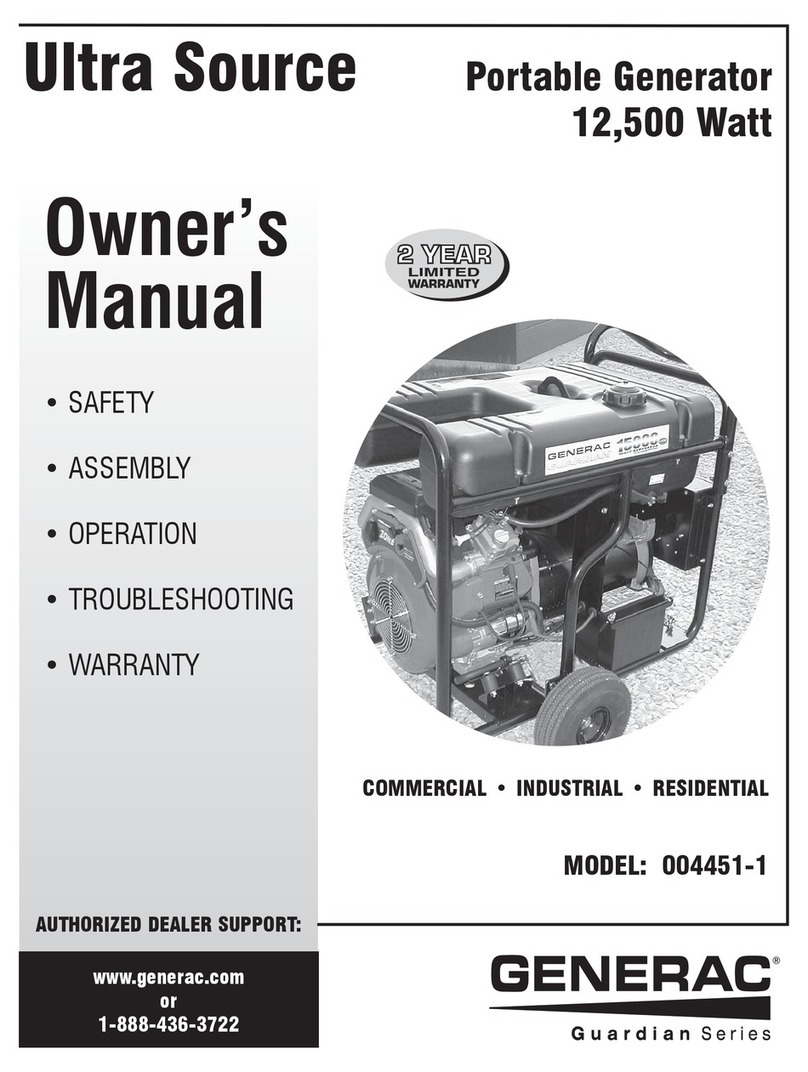
Generac Power Systems
Generac Power Systems Guardian Ultra Source 004451-1 owner's manual
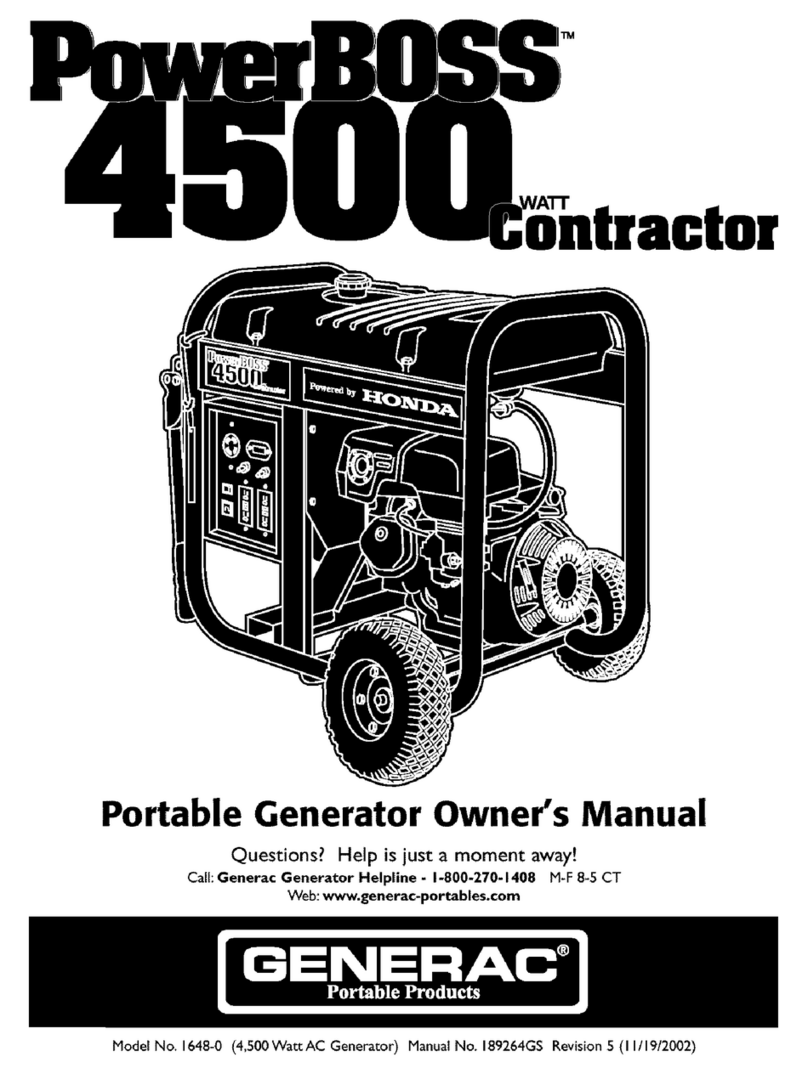
Generac Power Systems
Generac Power Systems PowerBOSS Contractor 1648-0 owner's manual
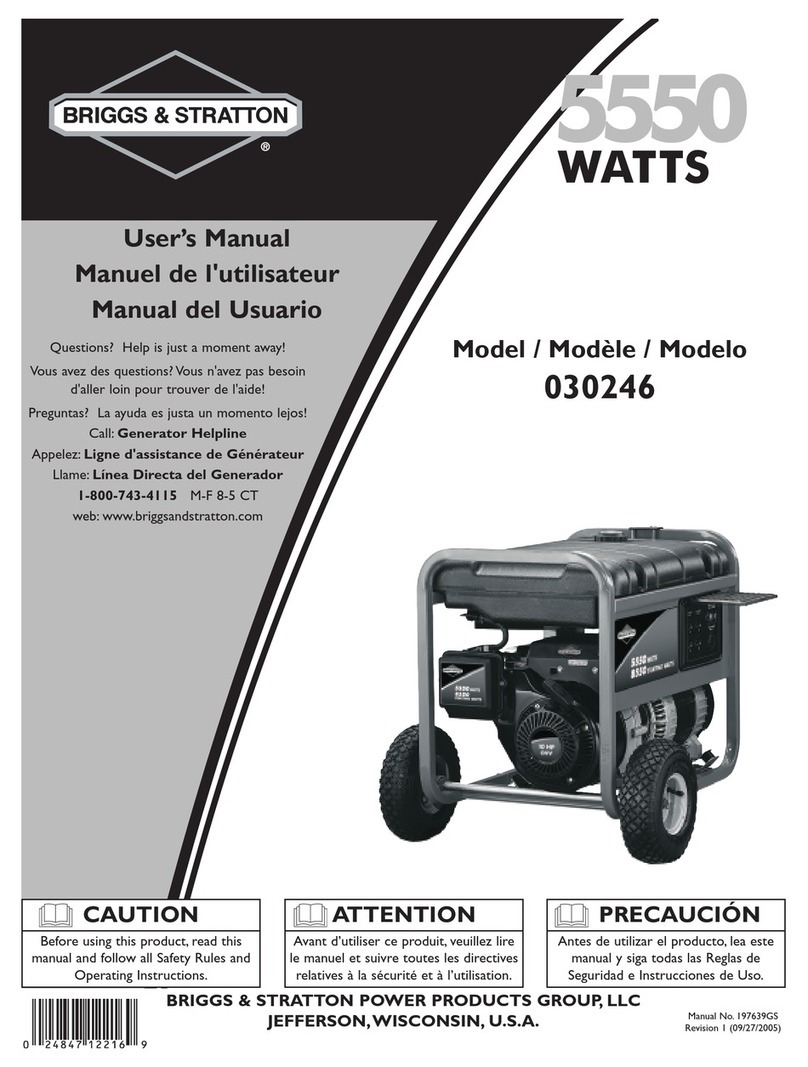
Briggs & Stratton
Briggs & Stratton 30246 user manual

Schulz
Schulz S950MG instruction manual

Hitachi
Hitachi E24SC Safety instructions and instruction manual

iPower
iPower GXS5000D owner's manual
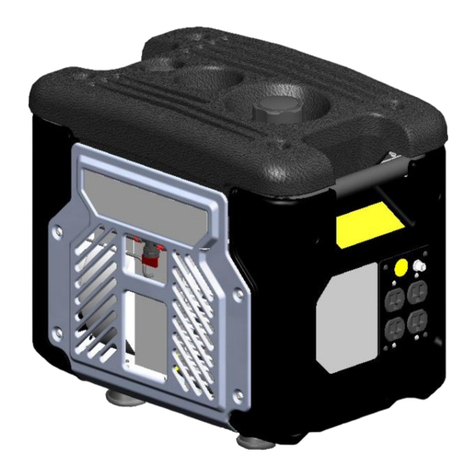
Powermate
Powermate Black Max PM0401858 user manual
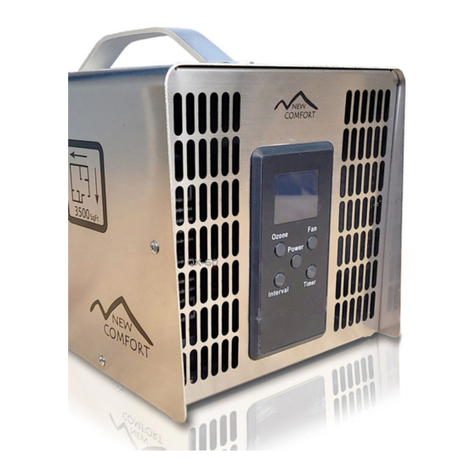
New Comfort
New Comfort SS12000 owner's manual
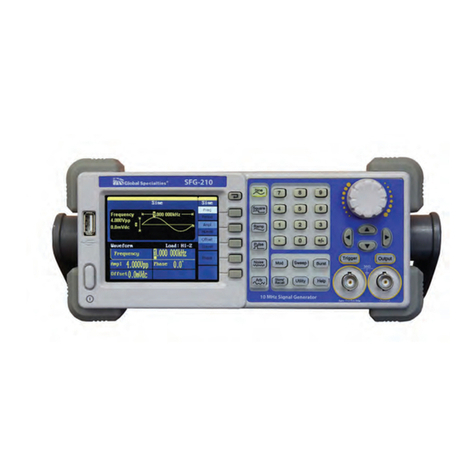
Global Test Supply
Global Test Supply SFG-205 user manual
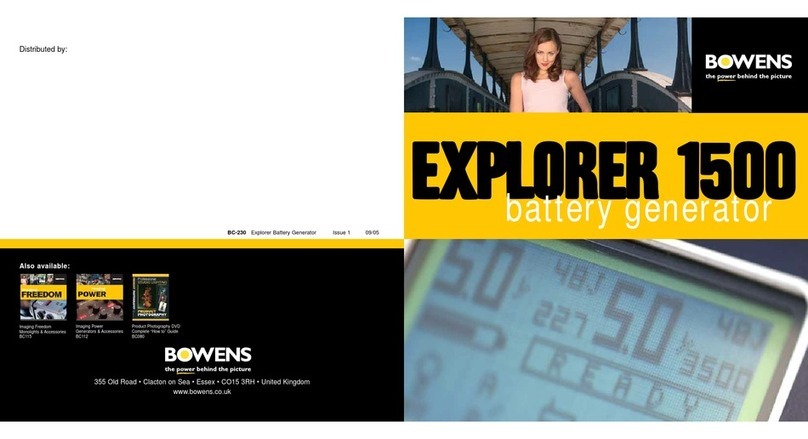
Bowens
Bowens EXPLORER 1500 Brochure & specs
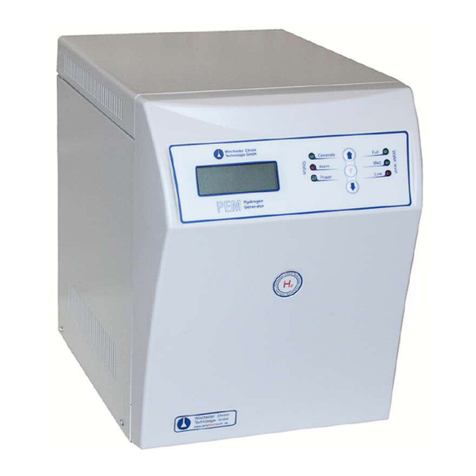
SCI
SCI PEM-HG Quick instruction manual

Champion Power Equipment
Champion Power Equipment 71307 Owner's Manual and Operating Instructions
